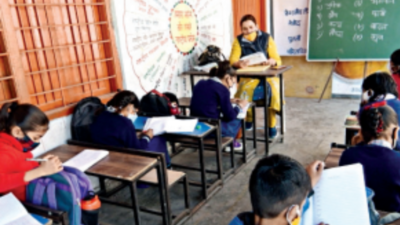Top Searches
- News
- City News
- bengaluru News
- Karnataka grade 3 students do well in English, struggle with math: Study
Karnataka grade 3 students do well in English, struggle with math: Study

School closure due to the pandemic created learning loss among students (Representative image)
BENGALURU: Grade 3 students from Karnataka fared relatively well in English, but only a little more than half could do division and a quarter couldn't do multiplication, as per a recent survey conducted by the National Council of Education, Research and Training (NCERT).
The national study - has been done in establishing a baseline for the NIPUN Bharat mission, a campaign by the ministry of education aiming for total foundational numeracy and literacy by the end of grade 3 - involved 4,046 students, with 426 tested in English, Kannada, Marathi and Urdu.
Foundational literacy comprises the ability of reading, writing and communicating in a language and includes skills such as oral language comprehension, phonological awareness and reading comprehension. For foundational numeracy, number identification, number operations, multiplication and division facts, measurement, and fractions are included. In most of the concepts, Karnataka fared better than the national average. In English, phonological awareness is as high as 97%. As much as 86% of the students could comprehend 4-5 texts, 98% could read letters correctly and 81% could read 80% of the words. A total of 33% students were learners with superior knowledge and skill. In Kannada, 83% could comprehend 4-5 texts, but 59% read letters correctly and fluently and 53% could read words correctly and fluently. In Marathi, 71% could comprehend texts, while 82% could in Urdu. In Marathi, 88% read letters and 82% words. It was 84% and 60%, respectively, in Urdu.
The worry is in mathematics. Only 62% could read numbers up to 9,999, while just about 57% could add up to 999. The students who could handle word problems ranged between 45% and 59%, while 75% could do multiplication and 55% could do division.
The task was based on problems using multiplication tables of numbers two to 10. Only 55% could tell time properly and 64% could do measurement.
Experts, however, opined that the number of students surveyed was too small. "Any research study on learning attainables is welcome. Studies are needed to get feedback on a system and engage in corrective action. This is not possible from FLS study. The samples of schools (0.69%) and students (0.36%) are extremely small to arrive at any working generalisation. Many background variables have also been left out," said educationist Seetharamu AS.
"School closure due to the pandemic has created learning loss. We are hoping the Vidyapravesh and Kalika Chetharike programmes have had impact. We plan to conduct a dipstick study in November-December to understand to what extent students have developed," said an education department official.
The national study - has been done in establishing a baseline for the NIPUN Bharat mission, a campaign by the ministry of education aiming for total foundational numeracy and literacy by the end of grade 3 - involved 4,046 students, with 426 tested in English, Kannada, Marathi and Urdu.
Foundational literacy comprises the ability of reading, writing and communicating in a language and includes skills such as oral language comprehension, phonological awareness and reading comprehension. For foundational numeracy, number identification, number operations, multiplication and division facts, measurement, and fractions are included. In most of the concepts, Karnataka fared better than the national average. In English, phonological awareness is as high as 97%. As much as 86% of the students could comprehend 4-5 texts, 98% could read letters correctly and 81% could read 80% of the words. A total of 33% students were learners with superior knowledge and skill. In Kannada, 83% could comprehend 4-5 texts, but 59% read letters correctly and fluently and 53% could read words correctly and fluently. In Marathi, 71% could comprehend texts, while 82% could in Urdu. In Marathi, 88% read letters and 82% words. It was 84% and 60%, respectively, in Urdu.
The worry is in mathematics. Only 62% could read numbers up to 9,999, while just about 57% could add up to 999. The students who could handle word problems ranged between 45% and 59%, while 75% could do multiplication and 55% could do division.
The task was based on problems using multiplication tables of numbers two to 10. Only 55% could tell time properly and 64% could do measurement.
Experts, however, opined that the number of students surveyed was too small. "Any research study on learning attainables is welcome. Studies are needed to get feedback on a system and engage in corrective action. This is not possible from FLS study. The samples of schools (0.69%) and students (0.36%) are extremely small to arrive at any working generalisation. Many background variables have also been left out," said educationist Seetharamu AS.
"School closure due to the pandemic has created learning loss. We are hoping the Vidyapravesh and Kalika Chetharike programmes have had impact. We plan to conduct a dipstick study in November-December to understand to what extent students have developed," said an education department official.
FOLLOW US ON SOCIAL MEDIA
FacebookTwitterInstagramKOO APPYOUTUBE
Start a Conversation
end of article









